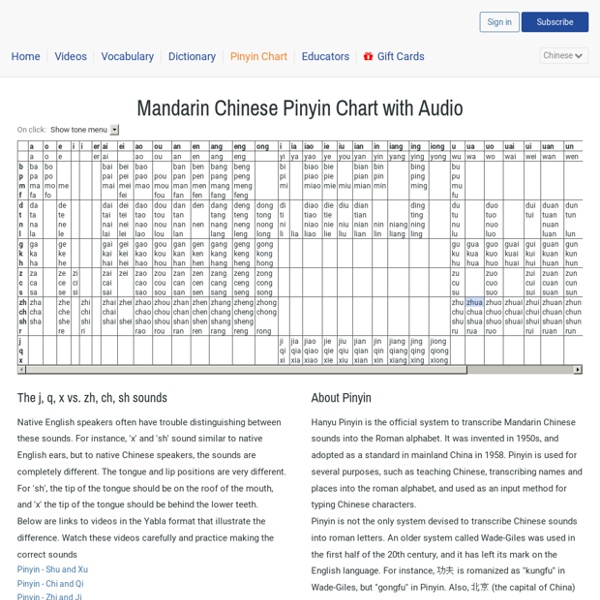Languages of California – Survey of California and Other Indian Languages
Two centuries ago, between 80 and 90 different languages were spoken within the boundaries of what is now the state of California. The indigenous languages of California belong to as many as 20 major language families; even accepting the controversial "Hokan" and "Penutian" groups, at least seven entirely unrelated language families are represented. For its size, California is linguistically the most diverse area of North America. Languages by family (see alphabetical list) California's indigenous languages and language families are listed below. Alphabetical list of languages (see by family)
Visually Learn Mandarin Chinese
Chinese
This course is designed to give a practical command of spoken Standard Chinese. Nine situational modules form the core of the course. Each core module consists of tapes, a student textbook, and a workbook. In addition to the core modules, there is a resource module and eight optional modules. Here is the outline of the course. The outline shows some modules that were never developed: there is no text for Module 9, there is no optional module for Institutions and Organizations, and there is no Module 10. Resource Module Module 1: Orientation Module 2: Biographic Information Module 3: Money Module 4: Directions Module 5: Transportation Module 6: Arranging a Meeting Module 7: Society Module 8: Traveling in China Module 9: Life in China Optional Module: Car Optional Module: Hotel Optional Module: Marriage, Birth, and Death Optional Module: Personal Welfare Optional Module: Post Office and Telephone Optional Module: Restaurant Supplementary Material (Under Construction)
The First 2000 Chinese Characters (bundle) | Mandarin Poster
A combination of our First 1000 and Second 1000 Chinese Characters Ebooks. Buy both books together and save a whopping 33% The definitive list of the most frequently used Mandarin Chinese characters, based upon the Chinese Ministry of Education’s official list, curated by us with love. Contains 4 books – Two for Simplified Chinese, Two for Traditional. Each book is over 200 pages long.
What is a milkshake duck? And why isn't it the word of the year? | Culture
In June 2016, Twitter user @PixelatedBoat coined a neologism that was arguably robbed as Oxford Dictionaries’ 2017 word of the year: “Milkshake duck”. The tweet went viral for neatly describing a now familiar arc, where the internet rushes en masse to embrace something or someone as cute, worthy, fun or funny – then just as quickly drops it, when it’s revealed to somehow be unpleasantly complicated. In just 140 characters, as was the style at the time, @PixelatedBoat encapsulated social media’s inclination to cast heroes and villains in black and white; to gloss over nuance and pay for it later; its short-sightedness, its fickleness, its breakneck pace, and its penchant for animals doing human things. With 30,000 favourites to date, the tweet is about as close to canon as it gets on a platform built for goldfish memories. “Milkshake duck is doing the rounds again,” observed @PixelatedBoat in May, nearly a year after the lovely, racist duck’s debut. *5 seconds later* A better example?
Wenlin Institute: Software for Learning Chinese
Is Rosetta Stone for Mandarin a good learning tool?
Configurando o Windows para escrever Chinês
Já aviso que este site não tem a intenção de se dedicar a uma plataforma específica como o Windows. Mas por ser este o sistema operacional que eu uso, vou publicar a dica que eu conheço para digitar em chinês. Sua contribuição para outros sistemas operacionais é bem vinda, me envie um comentário se desejar. Normalmente o iniciante em chinês é bastante curioso a respeito de como se faz para escrever em chinês no computador. Em primeiro lugar, coloque o CD de instalação do Windows XP no leitor de CD (não tem CD de instalação? Você poderá alternar as línguas presionando Alt+Shift simultanemente. Neste momento experimente digitar "nihao" no seu editor de texto para ver se você obtém 你好。 Esses passos assumem que você quer usar o Pinyin como método de entrada para caracteres simplificados.
Eggcorn
From Wikipedia, the free encyclopedia Altered phrase which is still plausible An eggcorn is the alteration of a phrase through the mishearing or reinterpretation of one or more of its elements,[1] creating a new phrase having a different meaning from the original but which still makes sense and is plausible when used in the same context.[2] Eggcorns often arise as people attempt to make sense of a stock phrase that uses a term unfamiliar to them,[3] as for example replacing "Alzheimer's disease" with "old-timers' disease",[2] or Shakespeare's "to the manner born" with "to the manor born".[1] Language change[edit] Eggcorns are of interest to linguists as they not only show language changing in real time, but can also shed light on how and why the change occurs.[3] Etymology[edit] Examples[edit] Similar phenomena[edit] Eggcorns are similar to but distinct from several other linguistic expressions:[22] References[edit] Further reading[edit] Diamond, Graeme (September 2010). External links[edit]
Reading Chinese Books with Hanping Chinese Camera
Hanping Chinese Camera is the Optical Character Recogniser (OCR) app for Android devices that accompanies Hanping Chinese Dictionary. The app lets you snap photos of Chinese text and view the definitions for words contained within. It’s become an integral part of my Chinese study routine that I can’t do without. Capture Text I usually read with my phone in one hand, Hanping Chinese Camera already open, and my book in the other, then when I come across a word I want to check I position my phone over the page and capture it. Hanping’s great advantage comes from the ability to pan around the photo once it’s been captured, so you can view the definitions for as many words as you want, rather than re-capturing on a word-by-word basis. Save Words to Lists To record the new words I have learnt I use the Tags feature of Hanping Chinese Dictionary. Export Definition Lists Here’s my exported word list from chapter 3 of Rework 工作大解放: Conclusion Dave Flynn View all posts by Dave Flynn →



